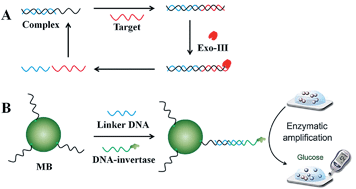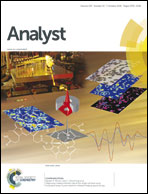Portable and sensitive quantitative detection of DNA using personal glucose meters and exonuclease III-assisted signal amplification
Abstract
A portable and sensitive quantitative DNA detection method using personal glucose meters (PGMs) and Exonuclease III-assisted signal amplification was developed. In the presence of target DNA, a target recycling process that can release target and linker DNA was obtained. The released linker DNA was used to link capture DNA on magnetic beads and the DNA invertase. After the washing away of unbound target DNA and subsequent DNA–invertase conjugation, the bound DNA–invertase can be used to catalyze the hydrolysis of sucrose into glucose with millions of turnovers, which transforms the concentration of target DNA into the level of glucose monitored by PGMs. There was a linear relationship between the signal of PGM and the concentration of target DNA in the range of 0.5 pM to 100 pM. A correlation coefficient of 0.989 was obtained, and the relative standard deviation (RSD) was 4.1% for a concentration of 50 pM target DNA (n = 9). In addition, the method exhibits excellent sequence selectivity, being able to differentiate a single mismatch in the target DNA. What is more, there was almost no effect from biological complexes on detection performance, which suggests our method can be successfully applied to DNA detection in real biological samples.


 Please wait while we load your content...
Please wait while we load your content...